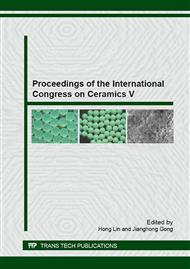p.126
p.132
p.136
p.141
p.147
p.153
p.159
p.164
p.168
Characterizations of (Mn, Sb) Co-Tuned PZMNS-PZT Piezoelectric Ceramics in the Morphotropic Phase Boundary and their Applications on Multi-Bulk Step-Down Piezoelectric Transformers
Abstract:
In this study, the (Mn, Sb) co-tuned PbCa0.01[(MnxZn0.1-x)1/3(SbxNb0.1-x)2/3 (Zr0.505Ti0.4895)0.9]O3 (PCZMNSZT-100x) ceramics were prepared near the morphotropic phase boundary (MPB) using the wolframite precursor method. The phase structure evolutions, electrical and temperature stability properties were systematically investigated. As the fraction of rhombohedral phase increases, the degree of disorder in the diffused phase transition (DPT) correspondingly increased and the “hard” piezoelectric characterization would be enhanced. Moreover, the temperature change rate of k, Qm and fr can be tuned by adjusting the x content. The specimens with x=0.08 exhibit the obtained values as kp ~ 0.50, kt ~ 0.52, Qm ~ 1550, and the low temperature change rate of properties having Δfr/fr = -0.02% and ΔQm/Qm = 10.5%, up to 100 °C. To evaluate the material feasibility, the proposed multi-bulk step-down transformers using a ring/dot structure are fabricated. Their obtained electrical properties have a maximum efficiency of 92% with an output power of 15 W, a voltage gain of 0.68 and a nearly zero temperature change rate of resonant frequency are found at the load of 100 Ω.
Info:
Periodical:
Pages:
147-152
Citation:
Online since:
July 2015
Authors:
Price:
Сopyright:
© 2015 Trans Tech Publications Ltd. All Rights Reserved
Share:
Citation:


